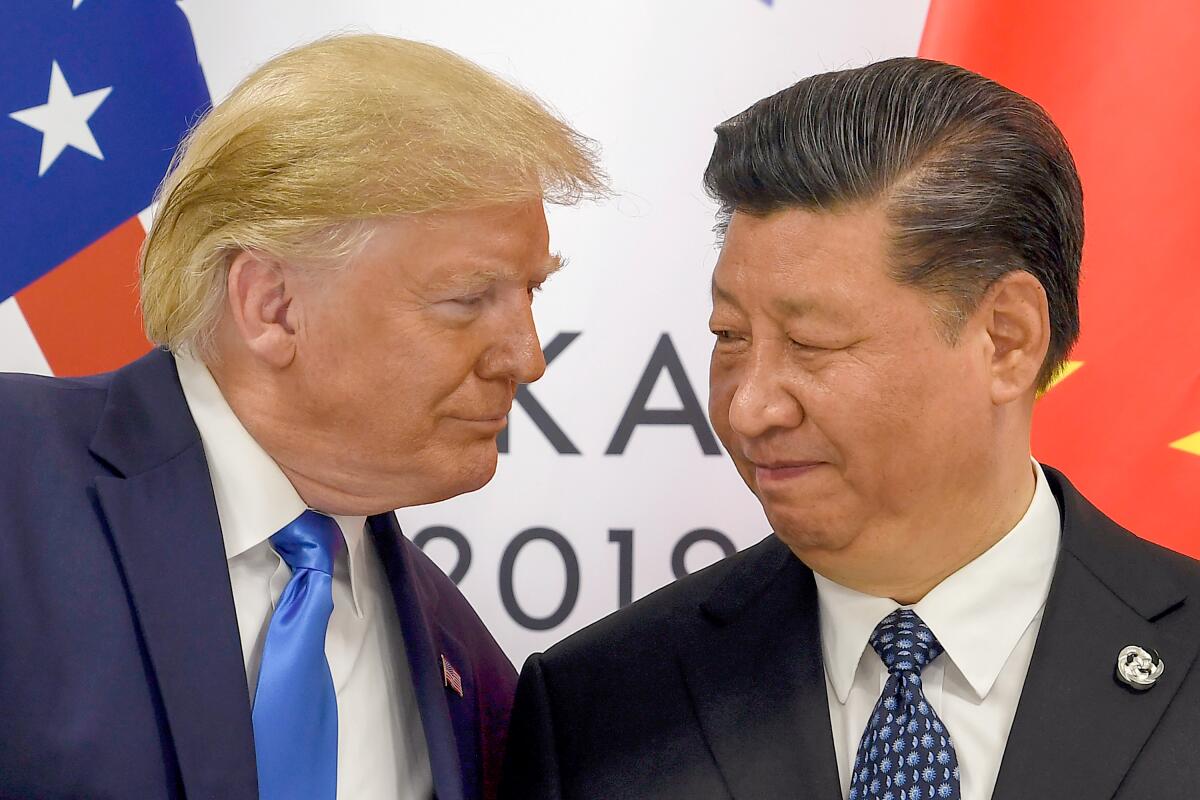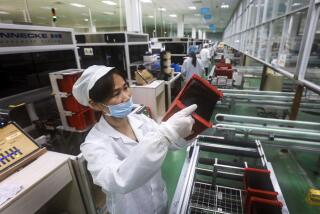New U.S.-China trade deal leaves the thorniest problems unresolved

WASHINGTON â After nearly two years of a bruising trade war, President Trump signed an initial trade deal with China on Wednesday that provides the president with political bragging rights but allows both sides to put off the most difficult disputes until after the November election.
Despite the ceremonial pomp of a White House signing event and Trumpâs extravagant remarks on his achievement, the so-called Phase 1 agreement only begins to address the potentially dangerous gulf between the United States and China on trade and economic policy.
Speaking in the East Room beside senior Chinese officials, Trump hailed the long-sought agreement as a âmomentous stepâ that was ârighting the wrongs of the past.â
The 86-page agreement, which the administration had kept under wraps until Wednesday, includes specific commitments by China to ramp up purchases of U.S. farm goods and other products and services, and to protect intellectual property and open up financial services.
In many cases, however, the agreement locked in commitments that China had adopted or were already in the works. And although analysts were encouraged that the two sides agreed to meet regularly in the hopes of keeping tensions at bay, the Phase 1 text made no mention of tariffs, let alone a plan to roll them back.
The Trump administration made only a small cut in tariffs on some Chinese goods, leaving in place hefty 25% duties on about $250 billion of imports from China. Beijing made no change in tariffs it has slapped on American products.
Trump described the roller-coaster negotiations, including punishing tit-for-tat tariffs over the last 18 months, as âtough, honest, open and respectful,â and said he would visit China âin the not too distant future.â
Although the signing signified a cease-fire in the trade war, the two nations remain on the cusp of long-term decisions that will have potentially harsh consequences for both Washington and Beijing.
The United States already has moved to restrict Chinese investments in America, deny licenses for Chinese telecom firms and blacklist others, notably Huawei. Research collaborations are coming under scrutiny and more Chinese international students are being denied visas.
âThat means that the fundamental tensions between the U.S. and China will not subside, even if the administration has achieved some incremental progress as well as met certain political goals that could calm the relationship for the short-term,â said Claire Reade, who served as first chief counsel for China trade enforcement at the Office of the U.S. Trade Representative from 2006 to 2010.
Over time, the relationship between the worldâs two economic superpowers seems all but certain to go in one of two directions.
In the best-case scenario, both governments would pull back from confrontation, expanding â not curbing â their mutual dependency on trade, and at least ameliorating some of Washingtonâs most serious grievances.
Those include industrial espionage such as cybertheft and Beijingâs heavy subsidies for its many state-owned enterprises that most economists say undercut foreign rivals and distort global markets. Neither is dealt with in the Phase 1 agreement.
âThis does not in any sense tackle the big systemic issues that the U.S. and China have on trade,â said Chad Bown, a trade expert at the Peterson Institute for International Economics, a nonpartisan think tank in Washington.
Robert Lighthizer, Trumpâs chief negotiator, acknowledged that the Chinese had actually made more commitments in the past than what is in the Phase 1 deal.
Whatâs new, he said, was the enforcement mechanism, and Lighthizer suggested that the Trump administration would not easily pull back from tariffs that remain on some $360 billion of Chinese products entering the United States.
âAny movement towards a Phase 2 depends on this being implemented,â he told reporters Wednesday.
At the White House ceremony, Liu He, Chinaâs vice premier and chief negotiator, read a letter aloud from Chinese President Xi Jinping. The agreement shows that the two countries can work on a âbasis of equality and mutual respect,â Xi wrote, expressing hope that âthe U.S. side will treat fairly Chinese companies and their regular trade and investment activities.â
Liu said that China would âstrictly honor the agreement, accommodate each otherâs core concerns, and ensure the good implementation of the Phase 1 trade agreement.â
For both sides, however, turning toward a strategy of compromise and short-term sacrifice instead of confrontation would be difficult under the best of circumstances. That may be especially true for the Chinese Communist Party and its elites, who are deeply invested in the status quo.
âXi Jinping made clear that their system is working very well and that theyâre not going to try to make their society or their economic system look like Western capitalism,â said Henry M. Paulson Jr., former Treasury secretary in the George W. Bush administration. He founded the Paulson Institute in 2011 to focus on U.S.-China issues and has been in regular contact with senior Chinese officials.
âThis is not the China we would like to have, but it is the China we got,â Paulson said in an interview. âWe are stuck with each other, and both sides have got to figure out a path forward which preserves global peace, stability and sustained economic growth in a rules-based system.â
Analysts fear that if the hard-line, nationalistic turn in both countries continues, as seems highly possible in view of a rising tendency among Americans to see China as an adversary, the result could be a new cold war.
That would potentially lead to a more isolated and embattled Beijing, with reduced access to Western markets that now support a Chinese economy still dependent on trade and foreign technology.
Eventually, China might be able to shift more assuredly to domestic consumption and homegrown innovation. But the transition, even if ultimately successful, would put enormous political pressure on a regime already becoming more and more authoritarian.
âThis may be as far as weâre going to go,â said David Bachman, a China expert at the University of Washington, referring to the Phase 1 deal.
âI think it was really an attempt to put the China dispute on the back burner until after the election, with expectation that the Chinese will step up their agricultural purchases significantly and that the Trump campaign can claim that farmers got a good deal,â he added.
Analysts examining the text of the agreement said there was plenty to be worried about. For one thing, the Chinese have said very little about it, and have yet to release a Chinese language version of it.
The English text is strongly worded, saying, for example, that China âshall ensureâ that its imports of U.S. goods and services increase by at least $200 billion over two years from the level in 2017. In that year, China purchased about $190 billion of products and services from the United States, according to U.S. figures.
Chinese farm imports would rise to about $40 billion this year and next on average from $24 billion in 2017, under the agreement, and there are numerical commitments for manufactured goods, U.S. energy and services.
Although U.S. farm and business groups welcomed those commitments, analysts questioned whether China had the capacity to make such large purchases, not to mention World Trade Organization rules and the strains that it could cause China with other trading partners.
Moreover, the text wasnât clear about what trade data would be used to determine whether China met its pledge, or whether an inability on the part of the Chinese to make purchases because of U.S. export controls could be counted against the commitment.
U.S. officials said that in the deal, Beijing would get a small rollback of tariffs, although there was no mention in the text.
Earlier this week, as a goodwill gesture, the Trump administration also withdrew its designation of China as a currency manipulator, although the label had little basis or practical significance.
In the agreement, China pledged to refrain from competitive devaluation of its currency and to certain transparency requirements â essentially restating a long-standing pledge.
The enforcement chapter set up a graduated process in which the two sides could bring complaints, appeal them to top trade officials, and allow the parties to ultimately withdraw from the agreement and take remedial action, presumably including new tariffs.
Trump has been consistent in demanding more Chinese purchases of U.S. goods and reducing the large American trade deficit, and he has had modest success. Less clear are his convictions and resolve in taking on China to make fundamental changes to its economic system.
âMy take on Phase 1 is that it largely restores the status quo,â said Scott Paul, president of the Alliance for American Manufacturing, a labor-industry proponent for fair trade. âIâm not optimistic that weâll get a Phase 2 deal thatâs going to dramatically alter the landscape.
âAnd in that way,â he said, Trump âwill have adopted the pattern of past administrations where they just kick the can down the road on these very tough issues.â
The one difference, Paul noted, is that Trump has made extensive use of tariffs and has kept most of them in place as leverage for future talks. That could push more U.S. multinationals with operations in China to look for new places for production and supplies, mostly in other parts of Asia.
At the same time, Trumpâs tariffs and Chinese retaliatory duties on American goods have not only squeezed farmers, but also caused a shrinking of business spending in the United States and volatility in stock markets.
âItâs going to take an all-out strategy from the administration,â said Paul, and Trump may not want to do anything to risk disrupting financial markets and the broader economy ahead of the November election.
âThe deal has some encouraging language, but its provisions still leave open questions around the severe structural issues in the U.S.-China trade relationship,â said Nick Marro, an analyst at the Economist Intelligence Unit. âThis, combined with likely difficulties in implementing many of these commitments, suggests that there is a high risk that the deal might fall apart later this year.â
More to Read
Get the L.A. Times Politics newsletter
Deeply reported insights into legislation, politics and policy from Sacramento, Washington and beyond. In your inbox three times per week.
You may occasionally receive promotional content from the Los Angeles Times.












